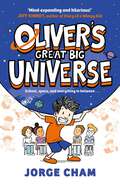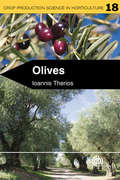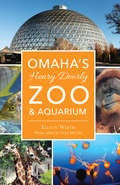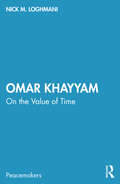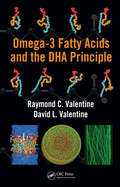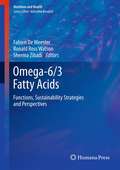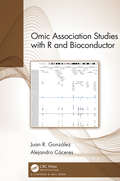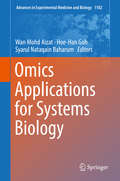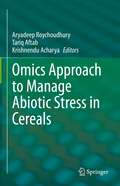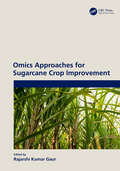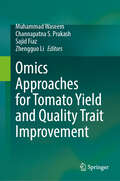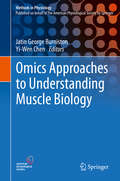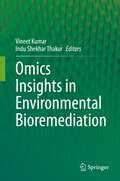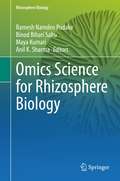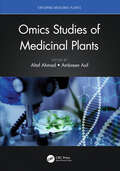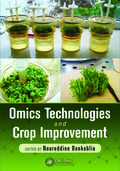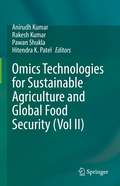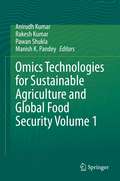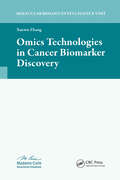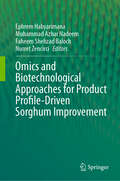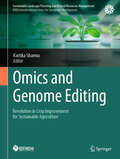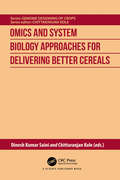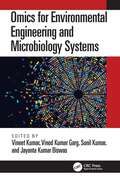- Table View
- List View
Oliver Gets Glasses
by Charnan SimonWhen Oliver cannot see the difference between cows and horses, his mom takes him to the eye doctor for the first time! Oliver learns about the eye and how it allows him to see. Dr. Walker then shows him how he is able to tell if the eye is healthy! Will Oliver need to get glasses?
Oliver's Great Big Universe: the laugh-out-loud new illustrated series about school, space and everything in between!
by Jorge Cham&‘Mind-expanding and hilarious!&’ Jeff Kinney, author of the bestselling DIARY OF A WIMPY KID series. This hilarious new illustrated series will make you laugh-out-loud AND grow your brain. Perfect for readers age 8+ and fans of Diary of a Wimpy Kid and The 13-Storey Treehouse. Hi, I&’m Oliver! I know what you&’re thinking: what does an 11-year-old kid know about the universe? Am I a famous scientist? No. Am I a super-genius? Not really. I&’m just trying to figure out the usual stuff: new school, new friends, how to avoid my annoying sister. But there&’s one thing that DOES make sense: science! Outer space is totally my thing and I can tell you EVERYTHING you need to know about awesome stuff like: time-bending black holes how the Big Bang is like a fart aliens! (Well, there could be aliens.) From bestselling writer and robotics engineer Jorge Cham, Oliver&’s Great Big Universe is the first book in a STEM-themed, diary-style series. &‘An absolute gem!&’ Lincoln Peirce, author of the bestselling series BIG NATE. &‘A stellar confluence of comic episodes and cosmic information. In addition to brilliantly integrated comic moments – surprising plot twists add narrative pizzazz to a serious raft of data about the universe. An irresistibly entertaining introduction to astrophysics.&’ – Kirkus starred review &★
Olives
by Ioannis TheriosOlive culture is growing rapidly, and expanding all over the world outside traditional centres of olive growth and production. Olives are not only a significant food source, but also contribute to human health and are becoming popular in health-conscious diets far beyond their Mediterranean origins.Reviewing an extensive array of literature from both a theoretical and practical perspective, this comprehensive guide deals with all aspects of olive culture, from its history, origins and traditional techniques to the latest horticultural procedures and basic physiology. The book's accessible and broadly illustrated format makes it an indispensable text for students, interested individuals and both active and amateur horticulturists.
Ollie and Harry's Marvelous Adventures
by Harry Ferguson Ollie FergusonOutdoor adventure and makerspace tech combine in this inspiring how-to from the brothers behind the popular Facebook page "The Days Are Just Packed." Ollie and Harry Ferguson have sailed a toy pirate ship across the Atlantic, engineered a giant catapult, and launched toy astronauts into space—and they haven’t stopped there. They’ve created a list of 500 adventures to help them live life to its fullest, from setting up a wildlife reserve to building an igloo. Ollie and Harry’s Marvelous Adventures features the best of the boys’ escapades, captured in vivid photographs and accompanied by step-by-step guidance on how to replicate them. The brothers’ days are just packed—and with the help of this inspiring guide, yours can be too.
Omaha’s Henry Doorly Zoo & Aquarium (Landmarks)
by Carol Mccabe Eileen WirthLong ranked as one of the top zoos in America and even the world, Omaha’s Henry Doorly Zoo & Aquarium’s history has remained untold, until now. Beginning as little more than a menagerie, the zoo transformed into a spectacular attraction that now draws two million visitors per year. Supporters responded to innovative features such as the iconic desert dome, the new African Grasslands exhibit, the indoor jungle and the all-encompassing aquarium. More than just a showcase, the zoo also supports renowned wildlife conservation and research programs that help preserve endangered species ranging from coral reefs to tigers. Author Eileen Wirth celebrates the history and promising future of the landmark that continues to elicit great local pride.
Omar Khayyam: On the Value of Time (Peacemakers)
by Nick M. LoghmaniThis book explores the life and work of Omar Khayyam as a provocateur of peace. While Khayyam is known for his poetry, he was foremost a prominent mathematician who looked at the world from a unique perspective. Using the transformative power of mathematics, he brought together seemingly irreconcilable concepts in his work. Through his art, philosophy, and mathematics, Khayyam sought to create harmony between what on the surface looks like a clash between his scientific view, romantic and often provocative poetry, and philosophy. The book sheds light on his spiritual and philosophical journey through a cross-sectional account of his poetry, philosophical view, and mathematics and science. It explores the complex inner life of a multidimensional scholar as he negotiated between faith and science, constructing a framework for peace by looking at the world as it presents itself to us, contemplating the temporality of life and enriching it with wisdom and joy. Historically and culturally informed, this book will be indispensable to readers of Omar Khayyam’s poetry and philosophy. It will also be of interest to students and researchers of peace and conflict studies, mathematics, science, Middle East literature, history, and popular culture.
Omega-3 Fatty Acids and the DHA Principle
by Raymond C. Valentine David L. ValentineThe physical-chemical properties of the omega-3 fatty acid DHA (docosahexaenoic acid) enable it to facilitate rapid biochemical processes in the membrane. This effect has numerous benefits, including those involved in the growth of bacteria, rapid energy generation, human vision, brain impulse, and photosynthesis, to name a few. Yet DHA also carrie
Omega-6/3 Fatty Acids
by Ronald Ross Watson Sherma Zibadi Fabien De MeesterOver the last several years developing human research suggests that a component of omega-3 fatty acids, long chain ones, contribute particularly to health benefits. Omega-6/3 Fatty Acids: Functions, Sustainability Strategies and Perspectives focuses on developing information on this newly recognized key component. This volume uniquely, and for the first time, focuses on sustainability of natural sources of omega-3 fatty acids variants including long chain ones, and on ways to increase their use and availability to reduce major diseases. The authors review cardiovascular disease, neurological changes and mental health and other diseases like diabetes where long chain omega-3 fatty acids play protective roles from recent human trials. Each chapter evaluates developing information on the possible mechanistic role of long chain omega-3 fatty acids. After showing their requirement and involvement in health promotion there are reviews of various sources and ways to protect and promote them. Authors provide support for the benefits and sources of long chain omega-3 fatty acids and their increased dietary intake that reduce various physical and mental illnesses. Omega-6/3 Fatty Acids: Functions, Sustainability and Perspectives is a unique and important new volume that provides the latest data and reviews to physicians who need to assess serum omega-6/3 and fatty acids to help diagnose risks and change diets and to inform industry and the scientific community with reviews of research for actions including new studies and therapies.
Omic Association Studies with R and Bioconductor
by Juan R. González Alejandro CáceresAfter the great expansion of genome-wide association studies, their scientific methodology and, notably, their data analysis has matured in recent years, and they are a keystone in large epidemiological studies. Newcomers to the field are confronted with a wealth of data, resources and methods. This book presents current methods to perform informative analyses using real and illustrative data with established bioinformatics tools and guides the reader through the use of publicly available data. Includes clear, readable programming codes for readers to reproduce and adapt to their own data. Emphasises extracting biologically meaningful associations between traits of interest and genomic, transcriptomic and epigenomic data Uses up-to-date methods to exploit omic data Presents methods through specific examples and computing sessions Supplemented by a website, including code, datasets, and solutions
Omics Applications for Systems Biology (Advances in Experimental Medicine and Biology #1102)
by Wan Mohd Aizat Hoe-Han Goh Syarul Nataqain BaharumThis book explains omics at the most basic level, including how this new concept can be properly utilized in molecular and systems biology research. Most reviews and books on this topic have mainly focused on the technicalities and complexity of each omics’ platform, impeding readers to wholly understand its fundamentals and applications. This book tackles such gap and will be most beneficial to novice in this area, university students and even researchers. Basic workflow and practical guidance in each omics are also described, such that scientists can properly design their experimentation effectively. Furthermore, how each omics platform has been conducted in our institute (INBIOSIS) is also detailed, a comprehensive example on this topic to further enhance readers’ understanding. The contributors of each chapter have utilized the platforms in various manner within their own research and beyond. The contributors have also been interactively integrated and combined these different omics approaches in their research, being able to systematically write each chapter with the conscious knowledge of other inter-relating topics of omics. The potential readers and audience of this book can come from undergraduate and postgraduate students who wish to extend their comprehension in the topics of molecular biology and big data analysis using omics platforms. Furthermore, researchers and scientists whom may have expertise in basic molecular biology can extend their experimentation using the omics technologies and workflow outlined in this book, benefiting their research in the long run.
Omics Approach to Manage Abiotic Stress in Cereals
by Tariq Aftab Aryadeep Roychoudhury Krishnendu AcharyaThe edited book highlights various emerging Omics tools and techniques that are currently being used in the analysis of responses to different abiotic stress in agronomically important cereals and their applications in enhancing tolerance mechanism. Plants are severely challenged by diverse abiotic stress factors such as low water availability (drought), excess water (flooding/ waterlogging), extremes of temperatures (cold, chilling, frost, and heat), salinity, mineral deficiency, and heavy metal toxicity. Agronomically important cereal crops like Rice, Wheat, Maize, Sorghum, Pearl Millet, Barley, Oats, Rye, Foxtail Millets etc. that are the major sources of food material and nutritional components for human health are mostly exposed to abiotic stresses during the critical phases of flowering and grain yield. Different Omics platforms like genomics, transcriptomics proteomics, metabolomics and phenomics, in conjunction with breeding and transgenic technology, and high throughput technologies like next generation sequencing, epigenomics, genome editing and CRISPR-Cas technology have emerged altogether in understanding abiotic stress response and strengthening defense and tolerance mechanism of different cereals. This book is beneficial to different universities and research institutes working with different cereal crops in the areas of stress physiology, stress-associated genes and proteins, genomics, proteomics, genetic engineering, and other fields of molecular plant physiology. The book can also be used as advanced textbook for the course work of research and master’s level students. It will be of use to people involved in ecological studies and sustainable agriculture. The proposed book bring together the global leaders working on environmental stress in different cereal crops and motivate scientists to explore new horizons in the relevant areas of research.
Omics Approaches for Sugarcane Crop Improvement
by Rajarshi Kumar GaurIn this book, the information encompasses various researchable biotechnology aspects of sugarcane, its genomic structure, diversity, comparative and structural genomics, data mining, etc. This book explores both the theoretical and practical aspects of sugarcane crops, focusing on innovative processes. This book argues in favor of developing an integrated research and development system to strengthen the research and development capabilities of all the areas of sugarcane. Further, it covers the recent trends of sugarcane biotechnology, especially in the next-generation sequencing (NGS) era. This book will be very useful for professors and scientists who are working in the area of sugarcane crops by using molecular biology and bioinformatics. It is also useful for students to use as a reference for their classes or thesis projects. Key features: • Discusses an integral part of molecular biology and pivotal tools for molecular breeding; enables breeders to design cost-effective and efficient breeding strategies for sugarcane • Discusses the harnessing genomics technologies for genetic engineering and pathogen characterization and diagnosis of sugarcane • Provides new examples and problems, added where needed • Provides insight from contributors drawn from around the globe
Omics Approaches for Tomato Yield and Quality Trait Improvement
by Muhammad Waseem Sajid Fiaz Channapatna S. Prakash Zhengguo LiThis volume explores the latest advancements and innovative techniques in the field of tomato breeding. The book delves into the cutting-edge research trends and methodologies aimed at enhancing tomato yield and improving its quality traits. It highlights the growing importance of molecular breeding approaches in addressing the challenges faced by the tomato industry. Tomatoes are one of the most widely consumed vegetables globally, and enhancing their yield and quality is of paramount importance for sustainable agriculture. Researchers and breeders are increasingly utilizing advanced molecular tools and techniques to dissect the genetic architecture underlying important traits in tomatoes. This book covers the integration of genomics, transcriptomics, proteomics, and metabolomics, enabling a holistic understanding of the molecular mechanisms governing tomato yield and quality. It explores how these omics-based approaches contribute to the identification of key genes and pathways associated with traits such as yield, flavor, color, texture, nutritional content, and disease resistance. It emphasizes the utilization of molecular markers and marker-assisted selection (MAS) in tomato breeding programs and explores how the identification and deployment of markers linked to desirable traits facilitate the selection of superior genotypes, accelerating the breeding process and improving efficiency. It explores the application of techniques such as CRISPR-Cas9, TALENs, and zinc finger nucleases for precise modification of target genes, leading to enhanced yield, improved quality, and resistance to biotic and abiotic stresses. The book highlights the potential of these molecular tools in creating novel tomato varieties with traits that meet the demands of consumers, markets, and sustainable agriculture. It showcases successful case studies, multidisciplinary collaborations, and global initiatives that contribute to advancing the field and overcoming challenges. This book serves as a valuable resource for researchers, breeders, and students interested in understanding and implementing molecular breeding strategies for enhancing tomato yield and improving its quality traits.
Omics Approaches to Understanding Muscle Biology (Methods in Physiology)
by Jatin George Burniston Yi-Wen ChenThis book is a collection of principles and current practices in omics research, applied to skeletal muscle physiology and disorders. The various sections are categorized according to the level of biological organization, namely, genomics (DNA), transcriptomics (RNA), proteomics (protein), and metabolomics (metabolite). With skeletal muscle as the unifying theme, and featuring contributions from leading experts in this traditional field of research, it highlights the importance of skeletal muscle tissue in human development, health and successful ageing. It also discusses other fascinating topics like developmental biology, muscular dystrophies, exercise, insulin resistance and atrophy due to disuse, ageing or other muscle diseases, conveying the vast opportunities for generating new hypotheses as well as testing existing hypotheses by combining high-throughput techniques with proper experiment designs, bioinformatics and statistical analyses. Presenting the latest research techniques, this book is a valuable resource for the physiology community, particularly researchers and grad students who want to explore the new opportunities for omics technologies in basic physiology research.
Omics Insights in Environmental Bioremediation
by Vineet Kumar Indu Shekhar ThakurEnvironmental pollution emanating from rapid industrialization, population growth, and urbanization has been considered a major problem in recent years that affects biodiversity, ecosystems, and human health by contaminating soil and water. This book brings out a comprehensive collection of information on valuable insights into different cutting-edge omics technologies, such as metagenomics, metatranscriptomics, metaproteomics, and metabolomics, along with advanced next-generation sequencing technologies as well as bioinformatic tools, which led to a better understanding of microbial communities and their adaptability to a wide range of contaminants and underlying their mechanisms in bioremediation and biodegradation of environmental pollutants. In addition, this edited volume provides critical insight into of potent microbial communities endowed with unique functional attributes through their unique metabolism catalyzed by ‘signature’ enzymes and degradation pathways. Step-by-step descriptions are provided of various microbial metabolic pathways of degradation and biotransformation of environmental contaminants by numerous illustrations which make the information easier to understand for the readers. Each chapter is devoted to selected examples of microbial bioremediation supported by tables, and an extensive list of references for readers interested in learning further details about the subject matter. This book is of interest to teachers, researchers to professionals, policymakers, stockholders, practitioners, environmental engineers, soil scientists, and policymakers. In addition, the book serves as additional comprehensive material for undergraduate, graduate, and doctoral students who require a working knowledge and knowhow of ‘Omics’ involved in and required for environmental remediation of legacy and emerging contaminants, will also find this to be a useful read.
Omics Science for Rhizosphere Biology (Rhizosphere Biology)
by Anil K. Sharma Ramesh Namdeo Pudake Binod Bihari Sahu Maya KumariThis book presents a timely review of the latest advances in rhizosphere biology, which have been facilitated by the application of omics tools. It includes chapters on the use of various omics tools in rhizosphere biology, focusing on understanding plant and soil microbe interactions. The role of proteomics and metagenomics in research on symbiotic association is also discussed in detail. The book also includes chapters on the use of omics tools for the isolation of functional biomolecules from rhizospheric microorganisms. The book’s respective sections describe and provide detailed information on important omics tools, such as genomics, transcriptomics, proteomics, metabolomics and meta-epigenomics. In turn, the book promotes and describes the combined use of plant biology, microbial ecology, and soil sciences to design new research strategies and innovative methods in soil biology. Lastly, it highlights the considerable potential of the rhizosphere in terms of crop productivity, bioremediation, ecological engineering, plant nutrition and health, as well as plant adaptation to stress conditions.This book offers both a practical guide and reference source for all scientists working in soil biology, plant pathology, etc. It will also benefit students studying soil microbiology, and researchers studying rhizosphere structure.
Omics Studies of Medicinal Plants (Exploring Medicinal Plants)
by Altaf Ahmad Ambreen AsifHerbal drugs play a pivotal role in modern medicine and pharmaceutical care; however, only limited biotechnology applications have been seen in medicinal plants. Revolutions in high-throughput approaches emphasize omics approaches, such as genomics, transcriptomics, proteomics, and metabolomics. A volume in the Exploring Medicinal Plants series, this book provides a comprehensive and in-depth analysis of breakthroughs in high-throughput approaches for the research of medicinal plants. Exploring the principles and applications of omics technologies, this book is essential for those working on or are involved in the modern research of medicinal and aromatic plants. There is also a strong focus on practical implications of these technologies through exploring the safety aspects and conservation strategies of various plants. From informative discussions on the latest research to a holistic evaluation of their potential applications, this book appeals to students, researchers and professionals working with medicinal and aromatic plants, as well as healthcare professionals interested in the area.
Omics Technologies and Crop Improvement
by Noureddine BenkebliaIncreased world population, decreased water supply, and climate change all put stresses on the global food supply. An exploration of the challenges and possible solutions to improve yields of the main crops, such as cereals, roots, tubers, and grasses, Omics Technologies and Crop Improvement reviews data on food sciences and omics. The book covers
Omics Technologies for Sustainable Agriculture and Global Food Security (Vol II)
by Rakesh Kumar Anirudh Kumar Pawan Shukla Hitendra K. PatelThis edited book brings out a comprehensive collection of information on the modern omics-based research. The main focus of this book is to educate researchers about utility of omics-based technologies in rapid crop improvement. In last two decades, omics technologies have been utilized significantly in the area of plant sciences and has shown promising results. Omics technology has potential to address the challenge of food security in the near future. The comprehensive use of omics technology occurred in last two decades and helped greatly in the understanding of complex biological problems, improve crop productivity and ensure sustainable use of ecosystem services. This book is of interest to researchers and students of life sciences, biotechnology, plant biotechnology, agriculture, forestry, and environmental sciences. It is also a useful knowledge resource for national and international agricultural scientists.
Omics Technologies for Sustainable Agriculture and Global Food Security Volume 1
by Rakesh Kumar Manish K. Pandey Anirudh Kumar Pawan ShuklaIncreasing world population, unpredictable climate and various kind of biotic and abiotic stresses necessitate the sustainable increase in crop production through developing improved cultivars possessing enhanced genetic resilience against all odds. An exploration of these challenges and near possible solution to improve yield is addressed in this book. It comprehensively and coherently reviews the application of various aspect of rapidly growing omics technology including genomics, proteomics, transcriptomics and metabolomics for crop development. It provides detailed examination of how omics can help crop science and introduces the benefits of using these technologies to enhance crop production, resistance and other values. It also provides platform to ponder upon the integrative approach of omics to deal with complex biological problems. The book highlights crop improvement such as yield enhancement, biotic and abiotic resistance, genetic modification, bioremediation, food security etc. It explores how the different omics technology independently and collectively would be used to improve the quantitative and qualitative traits of crop plants. The book is useful for graduate and post-graduate students of life science including researchers who are keen to know about the application of omics technologies in the different area of plant science. This book is also an asset to the modern plant breeders, and agriculture biotechnologist.
Omics Technologies in Cancer Biomarker Discovery
by Xuewu ZhangThe early detection of human cancer is still one of the great challenges in the battle against this disease. Single biomarkers are not likely to provide sufficient diagnostic power and multibiomarker assays should be developed in order to reach high diagnostic accuracy for cancer screening at the population level. Omics technologies are emerging ne
Omics and Biotechnological Approaches for Product Profile-Driven Sorghum Improvement
by Ephrem Habyarimana Nusret Zencirci Faheem Shehzad Baloch Muhammad Azhar NadeemThis edited book is focused on Sustainable Development Goal 2, which aims to achieve 'Zero Hunger.' It provides deep insights into the global sorghum status, limitations to its production, advancements in agronomic practices, and the application of high-throughput phenotyping technologies. Sorghum plays a vital role in global food security, agricultural sustainability, and rural livelihoods, making it an important crop for both developing and developed countries. It is a staple food for millions of people around the world, particularly in arid and semi-arid regions where other crops may struggle to grow. Sorghum exhibits significant genetic diversity, providing a rich resource for breeding programs aimed at developing improved varieties with traits such as higher yield, disease resistance, and nutritional quality. The book enhances readers' understanding of classical breeding methods and their role in sorghum improvement. It also focuses on the contribution of OMICs and biotechnological approaches to sorghum improvement. Detailed information about the genetic and genomic resources of sorghum provided is helpful for the scientific community to utilize in sorghum breeding. Chapters highlight sorghum genome sequencing, transgenic and hybrid sorghum, and the application of genome editing. This book is useful to the breeding community, serving as a resource for interdisciplinary research groups such as geneticists, breeders, biotechnologists, bioinformaticians, and students, supporting them in accelerating their activities related to sorghum breeding.
Omics and Genome Editing: Revolution in Crop Improvement for Sustainable Agriculture (Sustainable Landscape Planning and Natural Resources Management)
by Kartika SharmaThis book offers up-to-date research on genome editing and omics technologies from renowned academics with established backgrounds from throughout the globe. The world population is expected to touch 9–10 billion by 2050 and to feed the growing population, 50% more food must be produced globally than is currently produced. Nonetheless, it is a difficult challenge to increase the food output of the currently existing crops on available land. Over the past few decades, traditional crop enhancement techniques like plant breeding and other agricultural technology have made a significant contribution to food and nutritional security. With the use of strong technologies, genome editing strategies can significantly improve the productivity and efficiency of current agricultural practices. Discovering the underlying mechanisms influencing features of economic value has been made possible through genome editing through CRISPR/Cas9, primer and base editing, and OMICs through genomics, proteomics, metabolomics, transcriptomics, and phenomics. This book provides a wealth of information on omics and genome editing approaches and their application to develop abiotic, biotic, and climate-tolerant crops, as well as RNA interference, next-generation sequencing, and metabolomics for sustainable crop production. Researchers are actively using both genome editing and omics for crop improvement; however, there is limited literature offered in a single source. Undergraduate and postgraduate students, researchers, policymakers, and stakeholders will find this book to be an invaluable resource.
Omics and System Biology Approaches for Delivering Better Cereals (Genome Designing of Crops)
by Chittaranjan Kole Dinesh Kumar SainiThe book explores the available omics resources, the integration of multi-omics data, and systems biology methods, focusing on their applications in cereals breeding and research. It highlights current and innovative strategies to understand complex traits, to improve yield, and to enhance resistance to biotic and abiotic stresses. It also addresses the challenges and opportunities associated with modeling multi-omics data and analyzing systems-level information. By leveraging systems biology and integrated omics research, this book aims to redefine the future research agenda for cereal improvement.
Omics for Environmental Engineering and Microbiology Systems
by Vineet KumarBioremediation using microbes is a sustainable technology for biodegradation of target compounds, and an omics approach gives more clarity on these microbial communities. This book provides insights into the complex behavior of microbial communities and identifies enzymes/metabolites and their degradation pathways. It describes the application of microbes and their derivatives for the bioremediation of potentially toxic and novel compounds. It highlights the existing technologies along with industrial practices and real-life case studies. Features: Includes recent research and development in the areas of omics and microbial bioremediation. Covers the broad environmental pollution control approaches such as metagenomics, metabolomics, fluxomics, bioremediation, and biodegradation of industrial wastes. Reviews metagenomics and waste management, and recycling for environmental cleanup. Describes the metagenomic methodologies and best practices, from sample collection to data analysis for taxonomies. Explores various microbial degradation pathways and detoxification mechanisms for organic and inorganic contaminants of wastewater with their gene expression. This book is aimed at graduate students and researchers in environmental engineering, soil remediation, hazardous waste management, environmental modeling, and wastewater treatment.

